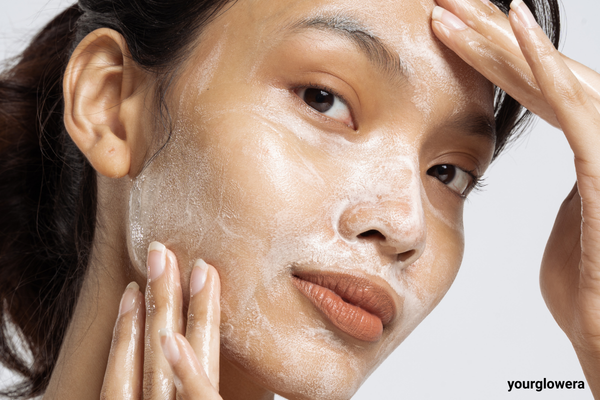Combination skin can often seem like a confusing riddle. One part of your face is oily, while another is dry or sometimes even flaky. Crafting a natural skincare routine for combination skin requires the right balance to ensure that all areas of your face get the care they need.
Whether you’re struggling with an oily T-zone or dry cheeks, we’ve got you covered! In this step-by-step guide, we’ll walk you through the essentials of a skincare routine for combination skin, provide product recommendations (including some amazing Indian natural brands!), and help you achieve glowing skin on a budget.
Table of Contents
What is Combination Skin?
Before we dive into the skincare routine, it’s essential to understand your skin type. Combination skin is a unique skin type where your face displays different characteristics in different areas.
The forehead, nose, and chin (T-zone) are often shiny or greasy, while the cheeks, temples, and under-eye areas tend to be dry or normal. Understanding this will help tailor your skincare routine to target both concerns simultaneously.
Why is using natural skincare products important for those with combination skin?
A natural skincare routine is ideal for combination skin because it uses gentle ingredients that can balance oil production without stripping the skin of essential moisture.
Natural skincare products are also often free from harsh chemicals, fragrances, and preservatives, which can aggravate sensitive areas of the face.
When your natural skincare routine for combination skin includes natural products, you are nourishing your skin with ingredients that maintain its health, restore its balance, and give it the natural glow you deserve.
Step 1: Cleansing – Use a soft, mild cleanser to clean your skin
The very first step in every skincare routine is washing your face with a gentle cleanser. For combination skin, it’s important to choose a cleanser that removes dirt, oil, and makeup without over-drying the skin or making it greasy. You need a gentle product that works well on both your oily and dry skin areas, supporting a natural skincare routine for combination skin.
How to Choose the Right Cleanser:
• For oily areas (T-zone): Choose a mild foaming cleanser or one with tea tree oil, which helps reduce excess oil.
• For dry areas (cheeks and under-eye area): Use a hydrating cleanser that doesn’t strip moisture from your skin.
Indian Brand Recommendation:
Try Biotique’s Bio Honey Gel Foaming Face Cleanser or Forest Essentials Delicate Facial Cleanser for a nourishing, gentle cleanse that will cater to your combination skin needs.
Step 2: Toning – Balance Your Skin’s pH
After cleansing, it’s time to tone. A toner helps bring back the skin’s natural pH and clear away any remaining dirt. For combination skin, choose a toner that moisturizes dry spots while reducing oil in the T-zone.
How to Choose the Right Toner:
• For oily areas: Look for a toner with ingredients like witch hazel or rose water, which are known to minimize excess oil.
• For dry skin: Pick a toner with gentle and moisturizing ingredients such as aloe vera or chamomile.
Indian Brand Recommendation:
Kama Ayurveda’s Pure Rose Water is perfect for combination skin. It provides hydration without being too heavy on the oily parts and soothes the dry areas.
Step 3: Exfoliation – Remove Dead Skin Cells
Exfoliating is an important part of your natural skincare routine for combination skin, but be careful! Over-exfoliating can irritate your skin, especially in the drier areas. A soft scrub or mild chemical exfoliant works best for combination skin.
How to Exfoliate:
• For oily areas: You can use a gentle scrub with fine granules or a chemical exfoliant with BHA (salicylic acid), which helps penetrate the pores and reduce oil buildup.
• For dry areas: Choose a mild scrub or opt for AHA (alpha-hydroxy acid) to gently exfoliate the surface without causing dryness.
Indian Brand Recommendation:
The Body Shop’s Vitamin C Glow Boosting Microdermabrasion is a great option for gentle exfoliation without damaging your skin.
Step 4: Serum – Target Specific Skin Concerns
Serums are concentrated formulations that target specific skin concerns, and they’re a great addition to a natural skincare routine for combination skin. Depending on your skin’s needs, choose a serum that will hydrate dry areas or control oil production where needed.
How to Choose the Right Serum:
• For oily areas: Opt for a serum with niacinamide or salicylic acid to control oil and minimize pores.
• For dry skin: Choose moisturizing serums with hyaluronic acid or vitamin C to increase hydration and help your skin appear more glowing.
Indian Brand Recommendation:
Mamaearth’s Skin Illuminate Vitamin C Serum is perfect for dry and oily skin as it provides an even skin tone while giving essential hydration.
Step 5: Moisturizing – Hydrate without Overloading
Moisturizing is very necessary, even if your skin gets oily. Dehydration can lead to more oil production, so it’s essential to use the right moisturizer as part of your natural skincare routine for combination skin.
How to Choose the Right Moisturizer:
• For oily areas: Choose a gel-based moisturizer or a lightweight formula that won’t clog pores.
• For dry areas: Go for a richer, cream-based moisturizer that provides deep hydration.
Indian Brand Recommendation:
Forest Essentials Light Day Lotion is a fantastic choice, offering hydration without clogging pores and keeping your skin moisturized throughout the day.
Step 6: Sunscreen – Keep Your Skin Safe Every Day
Whether your skin is oily, dry, or normal, using sunscreen is very must. Choose a broad-spectrum sunscreen with SPF 30 or higher to help protect your skin from damaging UV rays. Choose one that’s non-comedogenic (won’t clog pores) and lightweight.
How to Choose the Right Sunscreen:
• For oily areas: Opt for a gel-based sunscreen that provides sun protection without the greasy feel.
• For dry areas: Choose a moisturizing sunscreen that hydrates while protecting from the sun.
Indian Brand Recommendation:
Neutrogena Ultra Sheer Dry-Touch Sunblock SPF 50+ is a great choice that won’t make your skin feel oily.
Step 7: Weekly Skincare Routine – Don’t Forget the Extras!
Your weekly skincare routine should include treatments like masks or exfoliation to keep your skin in top shape. For combination skin, you can alternate between hydrating masks for dry areas and clay masks for oily spots, following a natural skincare routine for combination skin.
How to Add Extra Care:
• For dry areas: Hydrating masks with honey or aloe vera can help replenish moisture.
• For oily areas: Use a clay mask with bentonite or kaolin clay to draw out impurities and control oil.
Indian Brand Recommendation:
Kama Ayurveda’s Rejuvenating and Brightening Ayurvedic Night Cream provides deep nourishment for dry skin, while Innisfree’s Super Volcanic Pore Clay Mask helps control excess oil in the T-zone.
Final Thoughts – Achieving a Balanced, Glowing Complexion
Creating a natural skincare routine for combination skin doesn’t have to be complicated.
By following the steps above, choosing the right products, and adjusting your routine to your skin’s needs, you can achieve a beautiful, balanced complexion.
Don’t forget that consistency is key, and always make sure to protect your skin from the sun! With the right care, combination skin can thrive.
Conclusion
Mastering the art of a natural skincare routine for combination skin may take time, but it’s well worth the effort.
By using gentle, effective products, understanding your skin’s unique needs, and staying consistent with your routine, you’ll notice improvements in the balance and overall appearance of your skin.
Whether you’re looking for affordable Indian skincare products or simply seeking the best ways to treat combination skin, this guide is your ultimate resource.
Are you ready to see real transformation in your skin? This blog post, titled “Transform Your Skin with a Simple, Natural Skincare Routine for Combination Skin”, reveals how straightforward, natural methods can lead to remarkable results.
If you’ve been overwhelmed by complicated skincare routines, this post simplifies the process, showing you how to use natural ingredients to restore balance and clarity to your skin. It’s perfect for those who want effective results without the hassle or harsh chemicals.
By reading this article, you’ll discover how a simple, natural skincare routine for combination skin can help you achieve a healthier, more radiant complexion. It emphasizes ease and consistency, making it easy to incorporate natural practices into your daily life.
Whether you’re dealing with excess oil or dry patches, this guide offers practical solutions that will help you transform your skin naturally. Don’t wait—start your journey to better skin today by exploring this insightful blog.
Frequently Asked Questions (FAQs)
What is the 60-second rule in skincare?
The 60-second rule advises that you should cleanse your face for at least 60 seconds to ensure that you are effectively removing dirt, oils, and impurities.
Can we use rose water as toner?
Yes, rose water can be used as a gentle, hydrating toner for combination skin. It balances the skin and has anti-inflammatory properties.
How do I know my skin type?
To identify your skin type, wash your face with a mild cleanser, wait an hour, and observe the skin’s reaction. If it’s oily in the T-zone and dry on the cheeks, you likely have combination skin.
How can I improve my combination skin?
Balance your routine by using products suited for both oily and dry areas. Incorporate a gentle exfoliant and apply hydrating but lightweight moisturizers.
Is vitamin C bad for combination skin?
No, vitamin C is beneficial for combination skin. It brightens skin, reduces pigmentation, and helps with skin texture. Just make sure to use a stable form of vitamin C, like ascorbic acid.
How to control face oil naturally?
Use a gentle, oil-free moisturizer, and incorporate green tea or witch hazel into your routine to naturally reduce excess oil production.
What are the disadvantages of combination skin in a natural skincare routine for combination skin?
The main disadvantages include balancing products to address both oily and dry areas and dealing with breakouts or dryness in different zones.
Which face serum is best for combination skin?
Niacinamide serums help control oil, while hyaluronic acid serums hydrate dry areas. Both are good for combination skin.
Which is the best sunscreen to include in your natural skincare routine for combination skin?
La Roche-Posay Anthelios Dry Touch Sunscreen and Neutrogena Ultra Sheer Dry-Touch Sunscreen SPF 50+ are good choices for combination skin.
How do I simplify my skincare routine?
A simplified routine for combination skin includes a gentle cleanser, toner, moisturizer, and sunscreen.
What is the first step in a natural skincare routine for combination skin?
Begin with a gentle, natural cleanser that effectively removes dirt, excess oil, and impurities without stripping your skin’s natural moisture. Proper cleansing sets the foundation for balanced skin by preparing it for subsequent products. Use lukewarm water and massage gently to avoid irritation. This step helps prevent clogged pores and reduces shine, especially in oily areas, while keeping dry patches hydrated. Natural skincare routine for combination skin should start with this effective cleansing step.
How should I tone my skin naturally?
Use a natural toner like rose water, witch hazel, or cucumber water after cleansing to help tighten pores, restore pH balance, and calm your skin. Toners prepare the skin to better absorb moisturizers and serums, enhancing their effectiveness. Apply with a cotton pad or spray directly, focusing on oily zones, and gently pat into your skin. Regular toning helps maintain a fresh, balanced appearance and minimizes the appearance of pores, making it a key step in a natural skincare routine for combination skin.
When should I apply a natural serum or oil in my natural skincare routine for combination skin?
Apply a lightweight, natural serum or oil after toning and before moisturizing to target specific concerns such as dullness, fine lines, or uneven tone. Serums rich in antioxidants like vitamin C or hydrating ingredients like hyaluronic acid boost your skin’s vitality. Oils such as jojoba or rosehip can regulate oil production and nourish dry patches. Use a few drops and gently massage to ensure even absorption, maximizing their benefits. This is an essential step in a natural skincare routine for combination skin.
What’s the best way to moisturize combination skin naturally?
Choose a light, non-greasy moisturizer like aloe vera gel, rosehip oil, or jojoba oil that hydrates dry patches without making oily areas greasy. Apply a thin layer evenly across your face, focusing on dry zones, while avoiding over-application on oily areas. Natural moisturizers help strengthen your skin’s barrier, prevent dehydration, and reduce the chances of excess oil production. Consistent moisturizing keeps your skin soft, supple, and balanced—an essential part of a natural skincare routine for combination skin.
How often should I do masks in this natural skincare routine for combination skin?
Use natural masks about once a week, alternating between clay masks for oil control and hydrating masks for dry patches. Clay masks with ingredients like bentonite or kaolin absorb excess oil and tighten pores, while hydrating masks with honey, cucumber, or aloe vera soothe and nourish dry areas. Regular masking enhances your skin’s overall balance, improves texture, and keeps your complexion refreshed. Adjust frequency based on your skin’s needs and response, especially as part of a natural skincare routine for combination skin.
How do I incorporate sunscreen into my routine?
Finish your morning routine with a mineral-based, natural sunscreen containing zinc oxide or titanium dioxide to protect your skin from harmful UV rays. Apply generously to all exposed areas, 15-30 minutes before sun exposure, and reapply as needed. Sun protection is vital to prevent premature aging, hyperpigmentation, and skin damage. Using a natural sunscreen ensures your skin stays healthy while avoiding synthetic chemicals. Incorporate this step into your natural skincare routine for combination skin for optimal results.









Leave a reply